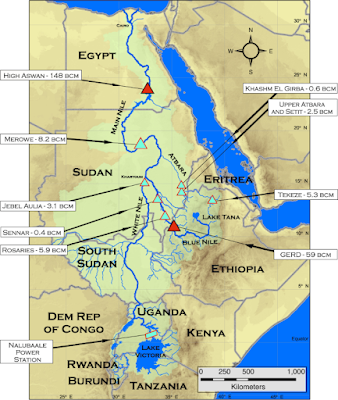The State(s) of the Nile
The Egyptian Nile?
Ancient Egypt's dependence on the Nile is a renowned fact. Egypt is most commonly associated with it, and vice versa, but why so? The Nile’s flow consists of the White and Blue Nile with their confluence in Khartoum, Sudan. The White Nile originates from water feeding into Lake Victoria (Uganda, Kenya, and Tanzania). More importantly, 85% of its streamflow consists of the Blue Nile sourced from the Ethiopian Highlands.
 |
| Figure 1: The River Nile and its 11 riparian countries |
 |
| Figure 2: Dam projects along the River Nile |
The Grand Ethiopian Renaissance Dam (GERD)
The GERD is located near Ethiopia's border with Sudan. With a reservoir volume of 67.37 billion cubic metres, it has the potential to provide 6.45 gigawatts of hydro-electric power. With the ability to provide electricity to Ethiopia's population, it helps counter the energy insecurity that the country faces with over 65 million people not having access to electricity. Moreover, it has facilitated job creation with its construction, and indirect operational jobs. The ability to export electricity only provides greater economic incentives to escape historical poverty. It is a no brainer for Ethiopia.
However, it has not been smooth-sailing. Contestation from downstream countries, predominantly Egypt, resulted in a political deadlock. Issues of secrecy in terms of the scale and impacts of the dam on Ethiopia's behalf have caused the breakdown of collaboration, which is furthered by Egypt's retaliation to the offense against its hegemony. The GERD represents a counter-hegemonic move that uses natural geographical advantages of being upstream to reshuffle the historical power asymmetries that have restricted Ethiopia.
This post discusses the historical dispute over claims to the River Nile, with more recent developments seemingly adding fuel to the conflict. However, could it be that modern counter-hegemonic discord may provide a path to better collaboration frameworks, especially for transboundary water resources?
Some food for thought before the next post!


Comments
Post a Comment